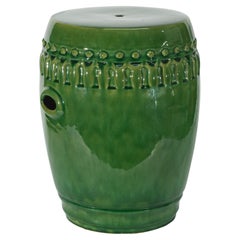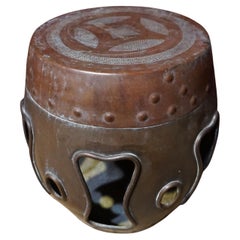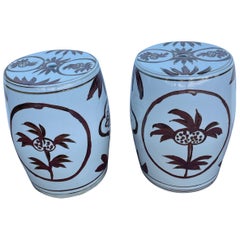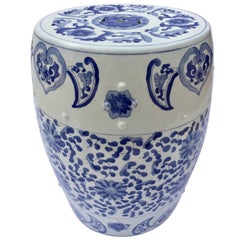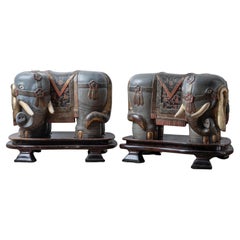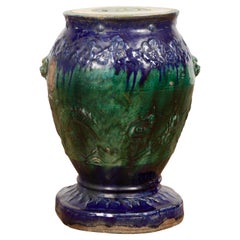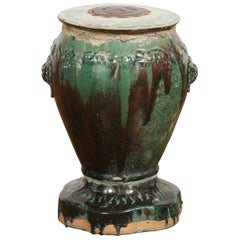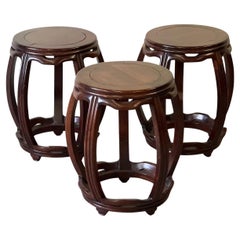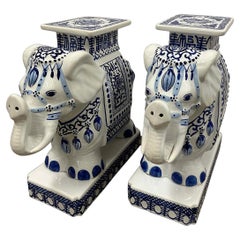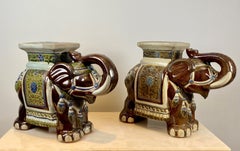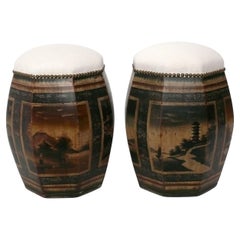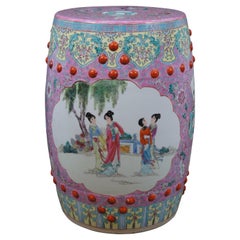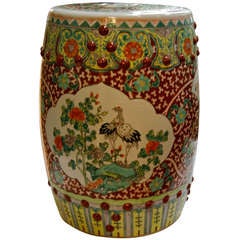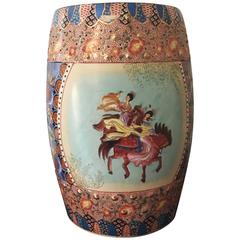Chinese Garden Stools
20th Century Chinese Chinoiserie Furniture
Ceramic, Porcelain
Antique 1890s Chinese Chinese Export Stools
Brass, Copper
20th Century Chinese Ceramics
Porcelain
Mid-20th Century Chinese Chinoiserie Patio and Garden Furniture
Ceramic
Early 20th Century Chinese Chinese Export Sculptures and Carvings
Wood
Antique 19th Century Vietnamese Patio and Garden Furniture
Ceramic
Antique 19th Century Vietnamese Garden Ornaments
Ceramic
Early 20th Century Chinese Ming Furniture
Rosewood
Mid-20th Century Chinese Chinese Export Ceramics
Porcelain
Mid-20th Century Chinese Antiquities
Ceramic, Porcelain
Vintage 1940s Chinese Chinoiserie Furniture
Upholstery, Wood
Vintage 1960s Chinoiserie Ceramics
Ceramic
Antique Early 19th Century Chinese Furniture
Wood, Elm
Antique 17th Century Chinese Ming More Asian Art, Objects and Furniture
Stone, Limestone, Granite
Antique 17th Century Chinese Ming More Asian Art, Objects and Furniture
Stone
Recent Sales
Vintage 1940s Chinese Ceramics
Mid-20th Century Chinese Chinoiserie Furniture
Ceramic
Late 20th Century Chinese Ceramics
Early 20th Century Chinese Ceramics
Mid-20th Century Chinese Chinese Export Furniture
Ceramic
Vintage 1970s Ceramics
Early 20th Century Furniture
Ceramic
Late 20th Century Chinese Furniture
Pottery
Vintage 1970s Chinese More Asian Art, Objects and Furniture
Pottery
Antique 19th Century Chinese Other More Asian Art, Objects and Furniture
Terracotta
Late 20th Century Asian More Asian Art, Objects and Furniture
Pottery
Mid-20th Century Chinese Mid-Century Modern Patio and Garden Furniture
Ceramic
Antique 19th Century Chinese Ceramics
20th Century Chinese Chinese Export Stools
Lacquer, Wood
20th Century Chinese Chinoiserie Stools
Ceramic, Porcelain
Early 20th Century Chinese Qing Stools
Mid-20th Century Asian Chinese Export Stools
Porcelain
Antique 19th Century Chinese Neoclassical Stools
Stoneware
Early 20th Century Chinese Qing Stools
Stoneware
20th Century Chinese Stools
Porcelain
Vintage 1970s Chinese Chinese Export Stools
Ceramic, Porcelain
Vintage 1970s Chinese Chinoiserie Patio and Garden Furniture
Ceramic
21st Century and Contemporary Chinese Furniture
Limestone
20th Century Chinese Ceramics
Ceramic
20th Century Chinese Furniture
Antique 19th Century Chinese Qing Asian Art and Furniture
Porcelain
20th Century Chinese Ceramics
Ceramic
Mid-20th Century Chinese Furniture
Ceramic, Porcelain
20th Century Chinese Chinese Export Ceramics
Early 20th Century Chinese Qing Side Tables
Porcelain
Vintage 1960s Chinese Ceramics
Porcelain
Late 20th Century Chinese Chinese Export Ceramics
Porcelain
20th Century Ceramics
20th Century Chinese Furniture
Ceramic
Mid-20th Century Chinese Chinese Chippendale Ceramics
Ceramic
Mid-20th Century Chinese Chinese Export Ceramics
Porcelain
Late 20th Century Chinese More Asian Art, Objects and Furniture
Pottery
Early 20th Century Furniture
Ceramic
20th Century Ceramics
Ceramic
Antique 19th Century Chinese Chinoiserie Furniture
Wood
Vintage 1960s Chinese More Asian Art, Objects and Furniture
Pottery
20th Century Chinese Chinese Export Ceramics
Mid-20th Century Chinoiserie Furniture
Wood, Lacquer
Early 20th Century Chinese Qing Furniture
Ceramic
Vintage 1970s Chinese Ceramics
Pottery
Late 20th Century Chinese More Asian Art, Objects and Furniture
Pottery
Vintage 1950s Chinese Hollywood Regency Antiquities
Terracotta
20th Century Chinese Qing Furniture
Ceramic
20th Century Chinese Chinese Export Ceramics
Porcelain
20th Century Chinese Furniture
Ceramic
Vintage 1970s Stools
Mid-20th Century Chinese Stools
Ceramic
Early 20th Century Stools
Early 20th Century Chinese Chinese Export Stools
Ceramic, Porcelain
Early 20th Century Chinese Chinese Export Stools
Ceramic, Porcelain
Mid-20th Century Chinese Chinese Export Furniture
Pottery, Stoneware
Early 20th Century Chinese Stools
Ceramic, Porcelain
People Also Browsed
Late 20th Century Chinese Chinoiserie Side Tables
Porcelain
21st Century and Contemporary American Pillows and Throws
Velvet, Silk
21st Century and Contemporary Italian Mid-Century Modern Flush Mount
Metal
21st Century and Contemporary American Sofas
Linen, Velvet
21st Century and Contemporary French Art Deco Stools
Iron
21st Century and Contemporary European Neoclassical Benches
Iron
20th Century European Art Deco Lounge Chairs
Fabric, Wood
20th Century American Mid-Century Modern Center Tables
Glass, Wood, Rattan
Mid-20th Century American Hollywood Regency Floor Lamps
Brass
21st Century and Contemporary Italian Pillows and Throws
Velvet
Mid-20th Century Mid-Century Modern Wall Mirrors
Glass, Walnut
20th Century American Organic Modern Dining Room Tables
Iron
2010s American Wall Lights and Sconces
Metal, Brass
2010s American Mid-Century Modern Chandeliers and Pendants
Nickel
Vintage 1970s Italian Mid-Century Modern Floor Lamps
Marble, Metal, Brass
2010s Italian Modern Chandeliers and Pendants
Brass
Chinese Garden Stools For Sale on 1stDibs
How Much are Chinese Garden Stools?
Finding the Right Asian Art And Furniture for You
From Japanese handmade earthenware pottery, originating circa 14,500 B.C. and adorned with elaborate corded patterns known as jōmon, to natural elm case pieces and storage cabinets built in Qing dynasty–era China to mid-century Thai rice-paper charcoal rubbings, antique and vintage Asian art and furniture make for wonderful additions to all kinds of contemporary interiors.
Eastern elements elevate any home’s decor. Introduce zen sensibility to your living room, dining room and bedroom with the neutral color palettes and the natural materials such as rattan, bamboo and elm that we typically associate with traditional Asian furniture. Decorative handwoven embroideries and textiles originating from India and elsewhere on the continent, which can be draped over a bed or sofa or used as a wall hanging, can be as practical as they are functional, just as you wouldn’t seek out Japanese room-divider screens — often decorated with paintings but constructed to be lightweight and mobile — merely for privacy.
With everything from blanket chests to lighting fixtures to sculptures and carvings, it’s easy to tastefully bring serenity to your living space by looking to the treasures for which the East has long been known.
For British-born furniture designer Andrianna Shamaris, the Japanese concept of beauty in imperfection isn’t limited to her Wabi Sabi collection. She embraces it in her New York City apartment as well. In the living area, for instance, she retained the fireplace’s original black marble while swathing its frame and the rest of the room in bright white.
“We left the fireplace very clean and wabi-sabi, so that it blended into the wall,” says Shamaris, who further appointed the space with a hand-carved antique daybed whose plush pillows are upholstered in antique textiles from the Indonesian island of Sumba.
In the growing antique and vintage Asian art and furniture collection on 1stDibs, find ceramics from China, antiquities from Cambodia and a vast range of tables, seating, dining chairs and other items from Japan, India and other countries.
 PAGODA REDOctober 7, 2020
PAGODA REDOctober 7, 2020Chinese round garden stools were made in a range of sizes, for use both indoors and out. Used as a form of casual seating as early as the Song dynasty (920-1279), these drum-form stools were common in Chinese aristocratic homes and were made with a variety of materials and decorative designs.
 Lotus GallerySeptember 23, 2020
Lotus GallerySeptember 23, 2020Yes! Chinese garden stools are a popular décor item and can be easily found in contemporary, vintage and antique versions. They are also known as drum stools.
 Lotus GallerySeptember 23, 2020
Lotus GallerySeptember 23, 2020No. Antique Chinese garden stools should be hand painted. Some antique English garden stools will have blue and white transfer decoration as do many modern and reproduction garden stools.
- What is a Chinese garden stool?1 Answer
 PAGODA REDOctober 7, 2020
PAGODA REDOctober 7, 2020The Chinese garden stool is a round, barrel-shaped stool with a circular seat. Inspired by traditional drums, these stools often feature decorative elements simulating actual drumheads, such as a ring of faux nails at each end.
- 1stDibs ExpertMay 5, 2023The point of a garden stool is to provide a place to sit in a garden. You might use one for comfort while you’re pruning low bushes or simply to relax and take in the beauty of your surroundings. People may also place flower pots or sculptures on garden stools. On 1stDibs, find a selection of garden stools.
- Why do garden stools have holes?1 Answer1stDibs ExpertApril 5, 2022Garden stools have holes in them to allow for the water to drain out instead of accumulating on top of the stool. Shop a collection of antique and contemporary garden stools from some of the world’s top sellers on 1stDibs.
Read More
Symbols of Happiness and Rebirth Adorn This Japanese Satsuma Bowl
Decorated with white cranes and the sought-after thousand-butterflies motif, the Meiji-period vessel offers both a celebration of traditional aesthetics and a clear reflection of the era’s appetite for exquisite export pieces.
Chicago’s Pagoda Red Has a Spirited Mix of Asian Antiques and Bold New Art
For 25 years, gallerist Betsy Nathan has leveraged her keen eye and key connections to bring a unique selection of rare finds to the market.
In L.A., Gallerist JF Chen Has Long Championed Eclectic Blue-Chip Design
Now working alongside his daughter Bianca, dealer Joel Chen has presented a most covetable array of antiques, art and contemporary creations for more than 40 years.
12 Calming Spaces Inspired by Japanese Design
From cherry-blossom-adorned walls paired with glamorous lighting to wood-paneled ceilings above checkerboard-patterned chairs, these 12 spaces seamlessly blend Eastern and Western aesthetics.
Rodrigo Rivero Lake’s Mexico City Showroom Is a Museum-Worthy Trove of Spanish Colonial and Asian Antiques
The dealer and curator has spent the past 50 years amassing a collection of exceptional art, furniture and architectural elements that trace the cultural influence of the Spanish empire from Europe to the Americas and beyond.
16 Refined Asian-Inspired Interiors
These spaces exemplify how Eastern elements elevate a home's decor.
